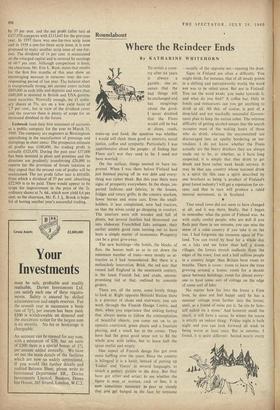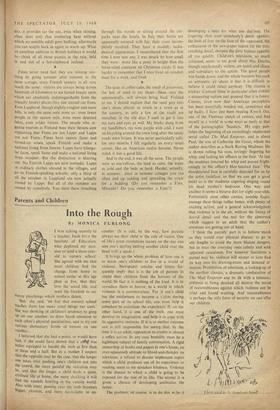Roundabout
Where the Reindeer Ends
By KATHARINE WHITEHORN To revisit a coun- try after six years is always a gamble : one as- sumes that the bad things will be unchanged and On the surface, things seemed to have im- proved. When I was there before Finland had just finished paying off its war debt and every- thing was rather bleak. But this year there were signs of prosperity everywhere. In the shops, im- ported fashions and fabrics; in the houses, fridges and rotary grills; in the country markets, fewer horses and more cars. Even the small- holders, it was complained, now had tractors, so that the wives could go shopping in comfort. The interiors were still wooden and full of plants, but several families had blossomed out into elaborate Frenchified fake antiques, their earlier austere good taste turning out to have been a simple matter of economics. Prosperity can be a great give-away.
The new buildings—the hotels, the blocks of flats, the houses built so as to cut down the minimum number of trees—were mostly as at- tractive as I had remembered. But there is a melancholy innovation. Brick, the red scar that ruined half England in the nineteenth century, is the latest Finnish fad, and crude, uncom- promising red at that, outlined by concrete girders.
There are, all the same, some lovely things to look at. Right opposite Helsinki Station there is a precinct of shops and stairways; you can work through the Finnish Design Centre, and then, when you experience that sinking feeling that always seems to follow the contemplation of beautiful objects, you come out on to an upstairs courtyard, green plants and a fountain playing, and a snack bar in the corner. They have had the great good sense not to fill the whole area with tables, but to leave half the space restful and empty.
One aspect of Finnish design has got even more baffling over the years. Since the country is bilingual it is a habit, instead of putting up 'Ladies' and 'Gents' in several languages, to attach a pottery picture to the door. But they have got artier and artier; to see whether the figure is man or woman, cock or hen, it is now sometimes necessary to peer so closely that you get banged in the face by someone
•
—usually of the opposite sex—opening the door.
Signs in Finland are often a difficulty. You might think, for instance, that of all steady points in a shifting and untrustworthy world, the word BAR was to be relied upon. But not in Finland. You see the word BAARI, you make towards it, and what do you find? A coffee bar. Only in hotels and restaurants can you get anything to drink at all. All this, of course, is part of a deep-laid and not markedly successful Govern- ment plan to keep the nation sober. The extreme difficulty of getting alcohol means that the search occupies most of the waking hours of those who do drink, whereas the uncommitted are discouraged into an apathy bordering on tee- totalism. I do not know whether the Finns actually are the heavy drinkers they are always made out to be, or whether, as I have long suspected, it is simply that they drink to get drunk and have rather weak heads anyway. It may be that any country whose national drink is a spirit (in this case a spirit described by one brochure as being 'a product of Finland's great forest industry') will get a reputation for ex- cess; and that in turn will produce a rabid teetotal movement, as in Scotland.
That small town did not seem to have changed at all; and it was there, finally, that I began to remember what the point of Finland was. As with really restful people, who are dull if you flash past them in ten minutes, you can miss the sense of a calm country if you take it on the run. I had forgotten the immense space of Fin- land. You can travel by boat for a whole day on a lake and see fewer than half a dozen villages; the forests stretch endlessly from the edges of the town; four and a half million people in a country larger than Britain have room to breathe. There is room: room to leave the trees growing around a house; room for a decent space between buildings; room for almost every- one to have some sort of cottage on the edge of some sort of lake.
No matter how far into the forest a Finn lives, he does not feel happy until he has a summer cottage even farther into the forest; until, as a friend of mine put it, 'he sits by him- self naked on a stone.' And however small the shack, it will have a sauna. In winter the sauna is strictly an indoor thing: Friday night is bath night and you can look forward all week to being warm at least once. But in summer, I found, it is quite different : heated nearly every day, it provides (as the sun, even when shining, often does not) that sweltering heat without which no sensible adult goes bathing; afterwards You can scuttle back in again to warm up. What an excellent addition to British holidays it would be—think of all those picnics in the rain, held in and out of a hot-cupboard instead.
Finns never need feel they are missing any- thing by going summer after summer to the same cottage, since Finnish scenery is all very much the same: visitors are always being driven hundreds of kilometres to see famed beauty spots which are absolutely indistinguishable from the (equally lovely) places they just started out from. Even Lappland, though slightly rougher and more hilly, is only the same only more so: even fewer people to the square mile. even more deserted lakes, even wilder forests. The people who or- ganise tourism in Finland wear their throats sore explaining that Finns are not Lapps and Lapps are not Finns. Finns have square faces and turned-up noses, speak Finnish and make a national living from forests; Lapps have triangu- lar faces, speak Same and make a national living from reindeer. But the distinction is blurring out. No Finnish Lapps are now nomadic. Lapps in ordinary clothes abound in the villages, and go to Finnish-speaking schools; only a third of all the reindeer in Lappland are now actually owned by Lapps. But all of the reindeer are owned by somebody. You meet them slouching through the woods or sitting around the car- parks near the hotels. In July their horns are apparently covered with fur, their coats incom- pletely moulted. They have a mouldy, lacka- daisical appearance. I remembered that the first time I ever saw one, I was struck by how small they were: more like a pony in height than the horse-sized creatures on Christmas cards. It was harder to remember that I once lived on reindeer meat for a week, and lived.
The taste ol• coffee-cake, the smell of pinewood, the feel of sand in my shoes—these, says she sentimentally, will always bring back Finland to me. I should explain that the sand gets into one's shoes almost as much in a town as in the country, as only a few of the roadS' are metalled; in the old days I used to get it into my ears and eyes as well. My books slung from my handlebars, my nose purple with cold, I went on bicycling around the town long after the sandy roads were frozen. It was never particularly safe; for two months I fell regularly on every street corner, like an American realist heroine. Never mind, it was a good life.
And in the end, it was all the same. The people were as marvellous, the land as calm, the water as cold and the beds as hard. Harder, actually, in summer: since in summer cottages you too often end up tedding and spreading the straw for a bedding. (Do you remember a Finn. Miranda? Do you remember a Finn?)



































 Previous page
Previous page